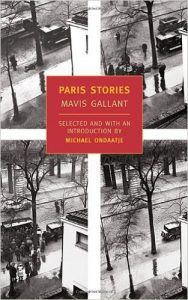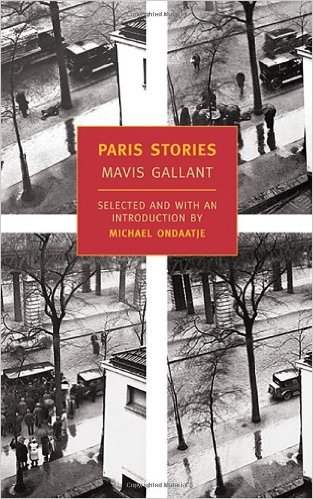 Ryan Ruff Smith: Mavis Gallant is one of those realists who, upon close examination, is weirder than anyone. Excepting one ghost story, the material collected in Paris Stories, a retrospective assemblage put together by NYRB Classics in 2002, is strictly grounded in reality. For the most part, this is the reality of post-World War II Europe. (The stories are not set exclusively in Paris, as the title may seem to suggest, but all of them were written there.) What makes Gallant’s writing so odd is less about content than structure. She’s a virtuoso of exposition and summary who doesn’t seem to have any particular regard for scene, that workhorse of most literary realism. It’s not that she can’t write them—there are scenes throughout Paris Stories that are sharp and unforgettable—but Gallant seems to care less about the usual beats of fiction than about sketching the contours of a life, or more precisely, a particular consciousness and sensibility, shown at a slant.
Ryan Ruff Smith: Mavis Gallant is one of those realists who, upon close examination, is weirder than anyone. Excepting one ghost story, the material collected in Paris Stories, a retrospective assemblage put together by NYRB Classics in 2002, is strictly grounded in reality. For the most part, this is the reality of post-World War II Europe. (The stories are not set exclusively in Paris, as the title may seem to suggest, but all of them were written there.) What makes Gallant’s writing so odd is less about content than structure. She’s a virtuoso of exposition and summary who doesn’t seem to have any particular regard for scene, that workhorse of most literary realism. It’s not that she can’t write them—there are scenes throughout Paris Stories that are sharp and unforgettable—but Gallant seems to care less about the usual beats of fiction than about sketching the contours of a life, or more precisely, a particular consciousness and sensibility, shown at a slant.
You never get the sense that any of these stories might be about her. They have the feel of train-notebook stories—observational, penetrating, and, within their realistic bounds, wildly imaginative. They are almost all told in close third person, though there is one in first and even one in second, the latter (“Mlle. Dias de Corta”) perhaps the most successful story of its kind that I’ve read. Where Gallant’s own sensibility comes through is in that slant—the sharp but subtle angle of vision from which she views her subjects. Her eye is keen, ironic, and sometimes vindictive. I fear that it’s become something of a cliché to say about a mean but funny writer—someone like Muriel Spark or Flannery O’Connor—that she is acerbic and cruel to her characters and yet also deeply sympathetic and fair. If this commonplace observation can be true, it’s certainly true of Gallant, but perhaps it’s more accurate to say that her characterizations are so fully fleshed out, so deeply imagined, that the questions of kindness and fairness become unyoked.
Here she is describing the couple at the center of the collection’s opening story, “The Ice Wagon Going Down the Street”:
“As a private married joke, Peter and Sheilah wear the silk dressing gowns they bought in Hong Kong. Each thinks the other a peacock, rather splendid, but they pretend the dressing gowns are silly and worn in fun.”
And again in “Specks’ Idea,” describing the modest Paris art dealer and gallerist Sandor Speck, an expert at dealing with artists’ widows:
“Sugar was poison to Speck. Henriette [his former second wife] had once reviewed a book that described how refined sugar taken into one’s system turned into a fog of hideous green. Her brief, cool warning, ‘A Marxist Considers Sweets,’ unreeled in Speck’s mind if he was confronted with a cookie.”
 What Gallant is having fun with in both passages is the absurdity of characters taking things seriously. Peter and Sheilah pretend to think the dressing gowns are silly in order to enjoy them in earnest. And surely, the preposterous title of Henriette’s review belies the narrator’s insistence on its “briefness” and “coolness”—and yet, the sentence illustrates the perfect seriousness with which Speck regards it.
What Gallant is having fun with in both passages is the absurdity of characters taking things seriously. Peter and Sheilah pretend to think the dressing gowns are silly in order to enjoy them in earnest. And surely, the preposterous title of Henriette’s review belies the narrator’s insistence on its “briefness” and “coolness”—and yet, the sentence illustrates the perfect seriousness with which Speck regards it.
Satire is too strong a word for what Gallant is up to here—satire in the sense of big targets, didacticism, broad swipes. The exposure of her characters feels less public than private—what Gallant is poking fun at is nothing less personal than their unspoken patterns of thought. This necessitates a sort of intimacy that is impossible without a degree of affection, and it is this strange mixture—biting wit tempered with a sense of warm familiarity—that makes Gallant Gallant. It is also what stands in for traditional drama in these dense and beguiling stories; rather than relying on plot and external event, Gallant builds narrative arcs out of the tension between the dispassion of observation and the vulnerable subjectivity of interior thought.











